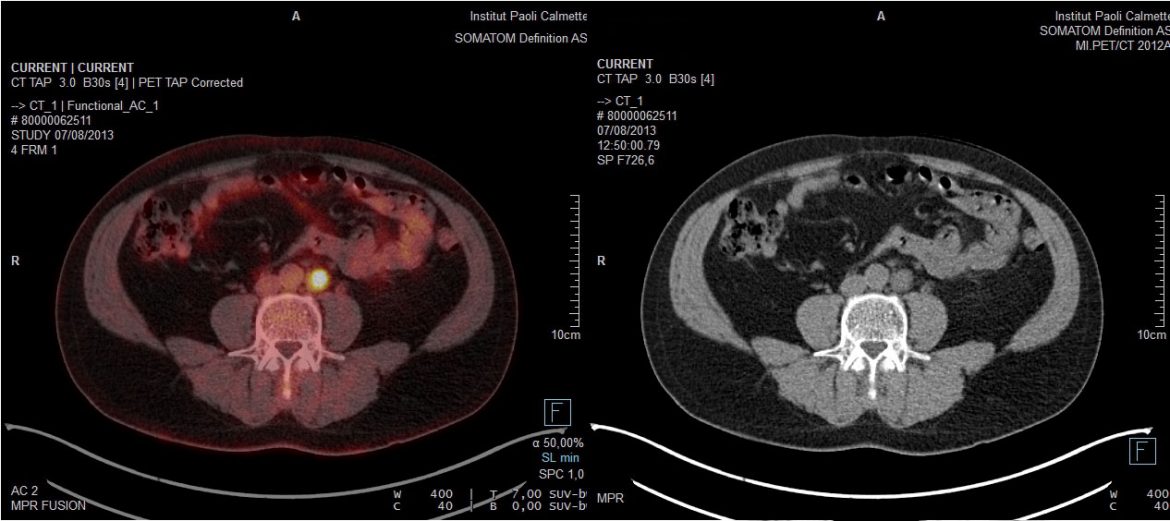PET scanning is a hot topic in uro-oncology and especially in prostate cancer it is becoming more popular. At the forthcoming 4th EAU Section of Urological Imaging (ESUI) Meeting to be held in Barcelona on November 12, and in conjunction with the 2015 EMUC meeting, the role of PET scanning in prostate cancer therapy will be closely examined.
In a joint session of the ESUI with the European Association of Nuclear Medicine (EANM) with “Molecular Imaging in Urology” as theme, a point-and-counterpoint discussion will focus on the value of PET scanning in prostate cancer (PCa) management.
Recent studies show that in initial staging the use of PET is limited by the relatively high false negative rate due to the small dimension of neoplastic lesions and the low spatial resolution of PET tracers. However, in the restaging setting for patients with biochemical recurrence, choline PET/CT may visualize the site of recurrence earlier and with higher accuracy than conventional imaging modalities. Other tracers such as FACBC and Ga-PSMA are emerging in recent literature with preliminary promising results. The information gained with PET/CT in this clinical setting has the potential to change disease management.
There is a caveat. PET/CT often remains negative in the early relapse situations when PSA levels are still very low (<1ng/ml). Unfortunately these levels are the “window” where salvage treatment will be most effective, especially when it comes to salvage radiotherapy after radical prostatectomy. Moreover, studies that thoroughly used histology to validate PET findings show a high number of false negative and false positive findings. As a result, the value of PET in the clinically relevant PSA ranges has little potential to change the management.
A critical discussion on the performance of PET in prostate cancer management is necessary to differentiate hype from scientific evidence. The ESUI has invited two experts who will highlight their point of view on PET and demonstrate why they think this imaging tool really changes PCa management or has no meaningful impact at all.
The usefulness of PET/CT in managing prostate cancer is supported by studies demonstrating that choline PET/CT has better accuracy to visualize disease relapse than conventional imaging. Several studies reported a sensitivity and specificity to correctly identify relapse in a range of 60-100% and 66-98%, respectively. Choline PET/CT has also opened new therapeutic options such as salvage lymphadenectomy or salvage LN irradiation. Riccardo Schiavina (IT) will argue in favor of PET/CT MRI as a helpful tool in restaging prostate cancer.
Arguments against such a capability is backed by studies that show very low rates of lesion detection at early biochemical recurrence in PSA ranges <0.5ng/ml, where only 5-8% of PET/CTs are positive. Even at PSA levels <1ng/ml only 5-20% of PET/CT are positive. Moreover, studies that evaluate PET/CT findings with extended salvage lymph node dissection (an experimental treatment approach), show false positive results of PET/CT in up 42% of patients, resulting to a large overestimation of disease stage and extent. These studies also show a high rate of false negatives of 61 to 79%. Regarding the role of new tracers, results are by far coming from single-centre experiences and require confirmation. Lars Budäus (DE) will argue against PET/CT as a helpful tool and will present his centre’s experiences with Ga- PSMA PET in high-risk PCa patients.
This exciting discussion will open the molecular imaging session that will highlight recent developments. During the EMUC meeting several other topics regarding the role of imaging in managing other urological malignancies will also be discussed in their clinical contexts.





